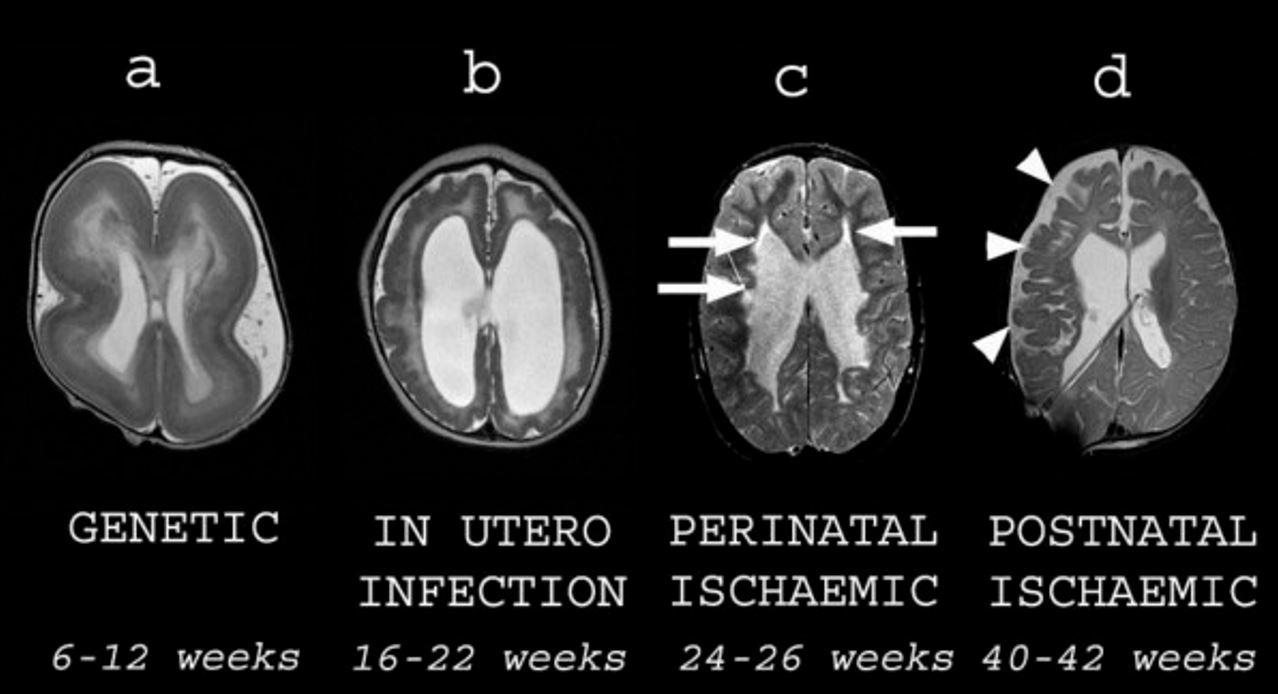Playlist
Show Playlist
Hide Playlist
Cerebral Palsy, Intellectual Disability and Autism Spectrum Disorder
-
Slides 13 PediatricNeuropathology Neuropathology II.pdf
-
Reference List Pathology.pdf
-
Download Lecture Overview
00:01 Here we have Cerebral Palsy, the static disorder of primarily motor deficit of cerebral origin. 00:09 Seizures are a common comorbidity and developmental delay or intellectual disability may be seen. 00:16 Incidence, pretty high -- 3 per 1,000 live births. 00:21 Different types: Spastic being the most common, hypertonic; You can have hypotonic (flaccid), ataxic, dystonic, which is athetoid, or mixed types of cerebral palsy. 00:37 Distribution: Hemiplegic, quadriplegic, or diplegic which then includes both the legs and the arms and you have a diplegic type of gait where you have circumduction that’s taking place of the legs as the patient’s moving from one side to the other. 00:54 Different distributions in terms of your patient with cerebral palsy, you pay attention to the diplegic gait please. 01:02 Risk factors: Prematurity, extremely common; low birth weight; chorioamnionitis -- infection of the placenta; prenatal virus infection, prenatal strokes, perinatal hypoxic-ischemic insult; all possible causes of cerebral palsy. 01:20 Intellectual disability, what does this mean to you? Below average intellectual function, usually an IQ of less than 70, below average adaptive behavior. 01:32 Not to be confused with developmental delay, the failure to reach a developmental milestone is developmental delay versus intellectual disability. 01:41 Continue discussion of intellectual disability, trauma could be a passive etiology, prenatal - postnatal. 01:47 Hypoxic-ischemic encephalopathy, TORCH organisms infection, chromosomal abnormalities such as Down Syndrome or Fragile X. 01:56 Metabolic disorders such as cretinism or accumulation of what's on is here a ganglioside or GM2, or from Tay-Sachs disease. 02:05 Toxins, fetal alcohol syndrome unfortunately being one of the most common causes of acquired intellectual disability in the US. 02:12 And we have perinatal hypoxic ischemic insult -- all possible causes of intellectual disability. 02:19 Now let’s move to Autism Spectrum Disorder. 02:21 According to DSM-5, Autism Spectrum Disorder is characterized by persistent deficits in social communication. 02:28 Patients have the impairment in social interaction and emotional reciprocity, restricted verbal and non-verbal communication skills, abnormal language development, lack of facial expression and impaired in personal relationships very early in life. 02:44 They also exhibit repetitive stereotypical patterns such as flipping objects, putting things in a row, performing rituals and rigid thinking. 02:55 Symptoms usually start before the age of three. 02:57 Children typically do not exhibit separation anxiety when they're separated from their caregiver and they show indifference to the external world. 03:06 These lead to severe functioning impairment. 03:10 The patient’s symptom etiology should not be better explained by intellectual disability or developmental delay.
About the Lecture
The lecture Cerebral Palsy, Intellectual Disability and Autism Spectrum Disorder by Carlo Raj, MD is from the course Pediatric Neuropathology. It contains the following chapters:
- Cerebral Palsy
- Mental Retardation
- Autism Spectrum Disorder
Included Quiz Questions
Which of the following is the most common risk factor for cerebral palsy?
- Preterm birth
- Polyhydramnios
- Oligohydramnios
- Eclampsia
- Preeclampsia
Which of the following conditions is most likely in a child with persistent deficits in social communication in multiple settings and restricted, repetitive patterns of behavior?
- Autism spectrum disorder
- Cerebral palsy
- Edward syndrome
- Down syndrome
- Tay-Sachs disease
Which of the following is an important nongenetic prenatal cause of intellectual disability?
- Fetal alcohol syndrome
- Down syndrome
- Autism
- Fragile X syndrome
- Tay-Sachs disease
Customer reviews
5,0 of 5 stars
| 5 Stars |
|
1 |
| 4 Stars |
|
0 |
| 3 Stars |
|
0 |
| 2 Stars |
|
0 |
| 1 Star |
|
0 |
Well-structured, with emphasis on high-yield pieces of info. Saves time for memorization





